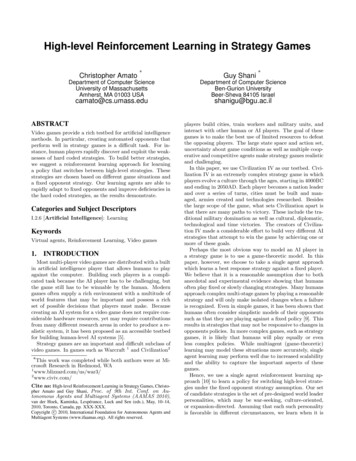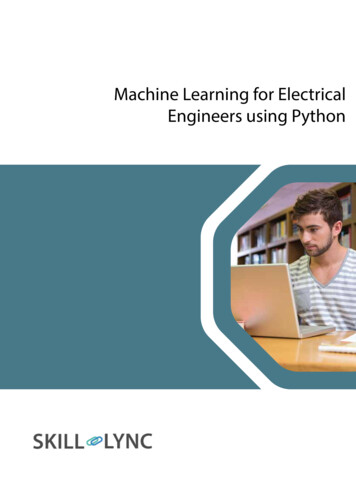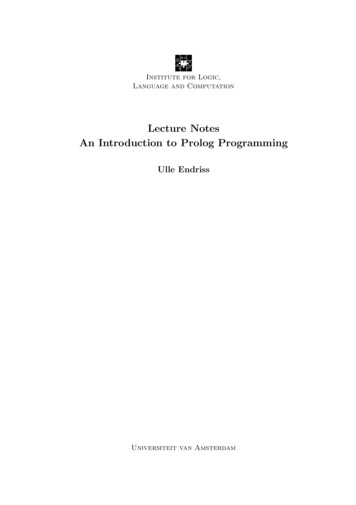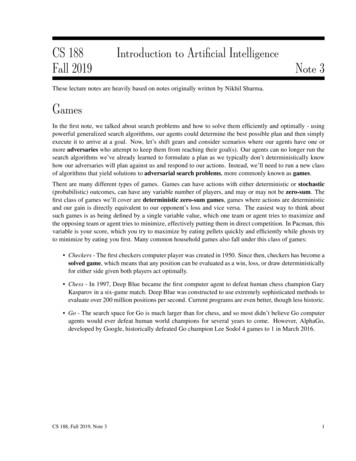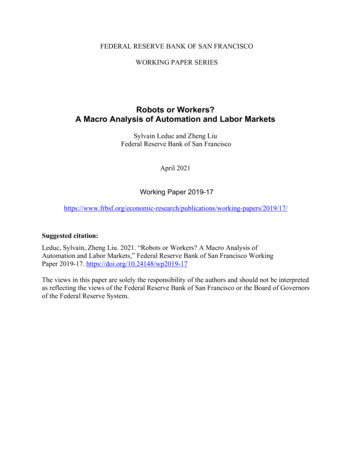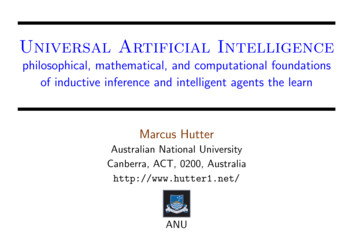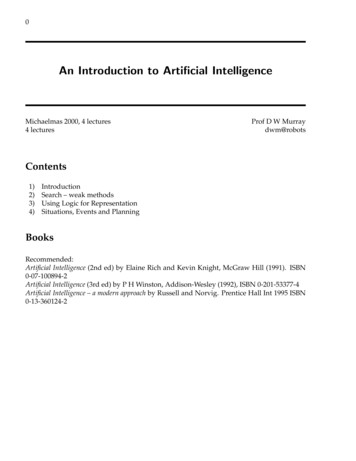
Transcription
0An Introduction to Artificial IntelligenceMichaelmas 2000, 4 lectures4 lecturesProf D W Murraydwm@robotsContents1)2)3)4)IntroductionSearch – weak methodsUsing Logic for RepresentationSituations, Events and PlanningBooksRecommended:Artificial Intelligence (2nd ed) by Elaine Rich and Kevin Knight, McGraw Hill (1991). ISBN0-07-100894-2Artificial Intelligence (3rd ed) by P H Winston, Addison-Wesley (1992), ISBN 0-201-53377-4Artificial Intelligence – a modern approach by Russell and Norvig. Prentice Hall Int 1995 ISBN0-13-360124-2
Lecture 1The essentials of AIReadingRich and Knight (1991) Chapter 1Winston (1992): Chapters 1 and 2.Also Russell and Norvig: Chap 2 on Intelligent Agents1.1BackgroundThe design and implementation of systems that possess, reason with, and acquire knowledge is arguably the ultimate intellectual challenge. So why then, when we open almost anybook on Artificial Intelligence, does it open with a painstaking, almost defensive, definitionof what AI is and what AI is not?Such caution is understandable, for during its short history AI has been dogged by periodsof scientific over-optimism followed by disappointment, echoed by similar cycles of mediahype’ and disenchantment. It is a young and developing discipline: one which has alreadyachieved much, but — if we believe the first sentence — has much to achieve. It is a subjecttoo which raises people’s inherent fear of the subjugation of their own intellect by machines,machines lacking in human fraility. Perhaps little wonder that AI is often misunderstoodand its current capabilities at once over-estimated by some and berated by others.As with anything, the nature of AI is best understood by looking at the subject’s achievements; but, for what they are worth, here are two definitions from opposite ends of a spectrum of ‘one liner’s’: AI is the attempt to build computational models of cognitive processes. AI is about generating representations and procedures that allow machines to performtasks that would be considered intelligent if performed by a human.The first points both to AI’s lofty goal and to its roots in pyschology, philosophy and linguistics. Artificial intelligence complements the traditional perspectives on intelligence gainedfrom those subjects because computer models force clarity of thought and precision, and1
2LECTURE 1. THE ESSENTIALS OF AIprovide generally useful, patient, but uncompromising experimental punch-bags. CreatingAI allows us to learn about “real” intelligence. The second one-liner is much more practically based and indicates why engineers should be interested in AI. If machines are able toact in an human-like intelligent manner, they will be more useful. The lofty goal of engineering, after all, is to put natural science usefully to work for mankind. Another one linerwhich appeals particularly to those involved in understanding perception is that AI is the the link between sensing of the world, perception of the world, and intelligentaction in the world.1.1.1Application domainsIt is possible to distinguish three rather different areas of application, expert task solving,natural task solving and formal task solving.Expert TasksThe most commercially advanced is the first, that of rule-based or expert systems. Theseare most often used as expert assistants in a wide range of fields. There are systems whichwould help with for example– Designing VLSI chips– Architectural design– Diagnosing infections– Advising on agriculture– Prospecting for oil and minerals– Solving symbolic mathematics– Diagnosing faults in aero engines– Analysis (science, finance etc)Although these are specialist or expert problems, one could pick similar problems whichconfront an average householder from day to day– Designing a DIY wardrobe– Planning a herbaceous border to provide year-round colour– Deciding whether a child has roseola infantum or german measles– Figuring out what is up with carand so on.When we think of these everyday problems, we realize that computers have made little impact on everyday decision making, and what enormous potential exists. The computers andcomputer output that most people rub up against routinely are of the cash-register variety
1.1. BACKGROUND3— the sort that add up you gas bill but don’t even bother to check that it is sensible (“unableto gain access . your bill for 73157.93 is an estimate”), or that lie as embedded processorsinside washing machines, microwave cookers and the like. If a general purpose computerexists in the home, it is most likely to be used merely as a glorified typewriter.Natural TasksThe second application domain for AI is the one related with linking sensing to action inevery day tasks. Here, as well as wanting to make an intelligent machine, we want it touse its intelligent to move around in and interact with its environment. We want intelligentrobots which can– Balance on less than three legs– Avoid lampposts– Recognize acquaintances– Grasp tools– Hold hands, and– Understand conversations– Perform commonsense ReasoningProgramming such natural tasks (tasks which we have taken for granted since the age oftwo) turns out to be hard. Indeed tasks which traditionally are thought of demanding thehighest intelligence — triple integration or whatever — are relatively straightforward toprogram — there are maths libraries each with several routines to do just that. Such tasksare already well-formalized, and their domain knowledge is complete.By constrast, the tasks towards which AI is focussed are difficult because they involve largeamounts of knowledge which may be uncertain and rather difficult to represent formally.The reasoning may involve intuitive processes, or at least processes whose underpinningreasoning is not at all obvious.Formal TasksThe final domain is that of formal tasks such as– Logic– Geometrical reasoning– Theorem proving– Game PlayingAI as a driving forceIn addition, one should add that AI has consistently probed problems which raise new challenges in systems design, in terms of both hardware and software.
4LECTURE 1. THE ESSENTIALS OF AI1.1.2The development of AIAI first flowered as a separate field of study in the 1950s, but one might look back a hundredyears or so to see that the seeds were already planted. It was in the 1840s that CharlesBabbage built his analytical engine, of which Lady Ada Lovelace, his patron, said: “Theoperating mechanism . might act on other things besides numbers were objects foundwhose mutual relations could be expressed by those of the abstract science of operations .”.Babbage was sadly too far ahead of his time to see anything come of his ideas.There were several fields of study which contributed to the initial growth of AI.First there was the work of mathematicians, in particular the logicians such as Godel, Church,Post and Turing, who devised formal methods such as propositional and predicate calculus by which facts and ideas expressed in understandable language could be manipulated.These ideas extended into linguistics, where formal grammars were devised. Second, a newarea of study call cybernetics brought together several areas where parallels could be drawnbetween human and machine performance. Thirdly, work was being undertaken in the areaof information theory in which Shannon was a prominent figure. Shannon also pioneeredthe possibility of playing chess by computer, and indeed described much of the backgroundto game playing theory. Fourthly there was increasing sophistication in neural function andmodelling. Finally, the crucial catalyst was the development of the electronic computer. Theessential advance here had been the invention of the valve in the 1920’s, and the first machines (eg the Mark I Harvard relay machine, and the U. Penn’s ENIAC) appear in the mid1940s. By the 1950s machines (eg the UNIVAC) were becoming commercially viable andmore widely available.Perhaps the germination of AI was the publication in 1950 of Alan Turing’s article Computing Machinery and Intelligence in which he proposed that machines could be programmedto exhibit intelligence and in which he described the famous Turing Test (although, he hadbeen nurturing the idea for some time). The first flowering (and apparently the first use ofthe term AI) is widely held to be at the 1956 workshop held at Dartmouth College. Its participants, among them Claude Shannon, John McCarthy, Herb Simon, John Newell, MarvinMinsky — were to dominate the subject for the next two an more decades.As mentioned earlier, in these early days there was considerable over-optimism about thescientific growth of AI, and it was not uncommon for the idea that machines would bemore capable than humans in a decade to be expressed. Given the illustrious nature ofthe key researchers, one can reasonably suppose that the reason for the optimism was notstupidity. Rather, it seems there were a number of significant early successes and rathertoo few setbacks to indicate just how difficult some of the problems (perception, learning,language understanding) would turn out.Amongst these early successes were The Logic Theorist, one of the first programs for automatic theorem proving (Newell,Shaw and Simon, 1957) Generative Grammars (Chomsky) Perceptrons (Rosenblatt, 1958)
1.2. THE ESSENTIAL INGREDIENTS5 Lisp programming language (McCarthy, 1958) A Geometry Prove (Gelernter) A Masters Level Draughts player (Samuel 1965) Dendral (a molecular structure analyser) (Lederberg, Feigenbaum and Djerassi 1965) The first version of Macsyma (Engelman, Martin and Moses 1968) Object recognition system, which could recognize simple wedge and cube shapes fromimagery (Roberts 1965). Resolution proofs in logic (Robinson 1965)The next advances came in the early seventies with the introduction of a major infectiondiagnosis system, MYCIN, the forerunner of rule-based systems, which began to take offcommercially in the early 1980s. The 1980s were years of considerable expansion of research into every aspect of AI, of considerable commercialization. Unfortunately there wasconsiderable over-selling of just one AI product, the so called expert-system — and “1st generation” expert systems at that, systems that only involve shallow knowledge. The skepticmight have asked whether the easy problems and solutions had all been creamed off, leaving the door open for another cycle of scientific disillusionment.There would be something in this, were it not for the considerable advances which havebeen made in the last decade in the difficult areas of natural processing. In vision, for example, there now exist stereo and motion systems, that deliver useful 3D descriptions of thesurrounding in real time, whereas at the beginning of the 1980s it was not clear whethersuch processing could be performed at all. There has been enormous growth too researchinto non-symbolic, or sub-symbolic, processing, the sort carried on in neural networks. Atfirst, it seemed that neural-networks were to suffer the same over-enthusiastic treatmentthat was given to expert systems, but it now seems that there is a reasonable and reasoneddebate about the role and place of such systems vis-a-vis symbolic computation.1.2The essential ingredientsWhatever ‘definition’ of AI one prefers, an essential tenet of the subject must be that human-like reasoning is a form of computation that may be identified, formalized andconsequently automated.Newell and Simon say something rather stronger in their Physical Symbol System hypothesis. A PSS consists of a set of entities called symbols which are physical patterns that canoccur as components of another type of entity called an expression or symbol structure. Atany instant the system is a collection of symbol structures. Besides these, the system has alibrary of processes at its disposal which operate on expressions by creation, modification,reproduction and destruction. A PSS is one which contains a time-evolving collection of
6LECTURE 1. THE ESSENTIALS OF AIsymbol structures. Such a system exists in a world of objects wider that just these symbolicstructures themselves. The hypothesis itself says: A physical symbol structures has the necessary and sufficient means for general intelligent action. There is support for it from across AI’sspectrum of problems — for example, from game playing, where one might expect support;to vision, where one might expect there to be non-symbolic processing.The need for symbolic processing for intelligence is contentious, but for our purposes all weneed to accept is that much of AI’s progress to date has been based on symbolic processing.The received experience from the past 40 years can be summed up in four messages:1. Intelligence needs knowledge, and knowledge needs representationKnowledge, or facts about the world and problem domain, are essential. In the earlydays of AI there was an emphasis on general problem solving, but is was found thatsuch solvers only worked when supplied with a large amount of domain-specificknowledge: no longer were they general.Knowledge, then is crucial — but it has less endearing characteristics: First there is usually a lot of it: indeed, it appears that human expertise in an areacomes in chunks of 7 2 104 items (eg the number of board positions known bychess masters, the number of words in a graduate’s vocabulary, etc.). Secondly, knowledge is not static. It is for ever changing as a consequence ofevents. Thirdly, in its raw state it is neither succinct nor uniform. For example, bothwords and pixels in the aphorism “one picture is worth a thousand words” portray the same world situation, but each is quite different. Is each word of equalimportance? Is each image pixel of equal importance? Of course not. Becauseof this non uniformity, we require formalized (and uniformalized) internal representations — ones which make the essential distinct from the trivial. Representations are sets of conventions about how to describe a thing or class of things.A description uses the convention to describe a particular instance of object. Ifall knowledge were uniformly pertinent, then the role of representation wouldbe unimportant, but it turns out that the choice of representation can often makethe difference between finding a solution to a problem and failing utterly. Goodrepresentations make problem solving easier by exposing the essential.A representation has four parts to it: Lexical part — this determines what symbols are allowed. Structural part — this determines how the symbols can be arranged Semantic part — this attaches meanings to the descriptions. Procedural part — this gives access functions that allow you to write and readdescriptions into the structure, to modify them and to interrogate them.2. Intra- and inter-representational changes require reasoning processes.It is perhaps more correct to say that reasoning processes are such those which createintra- and inter-representational changes. It is rare for knowledge of a particular domain to be such that reasoning proceeds inexorably. More often you will be faced with
1.2. THE ESSENTIAL INGREDIENTS7choices which have to be made without full knowledge of the consequences, in whichcase you will need to search for possible solutions.Search is a key process in AI, and is inextricably linked with knowledge. There areseveral points: Search compensates for lack of knowledge. When faced with a puzzle we haven’t seenbefore we don’t give up: we engage in trial-and-error behaviour, usually untila solution is found. Note that search is often required even where the domainknowledge is complete: we often cannot make a decision without exploring several options until they turn into dead-ends. More knowledge reduces search. One can easily think of examples where a specificextra piece of knowledge can cut out wasteful search. But another aspect is turning cognitive actions into skills. Eg, by practicing and learning a piece of music. There is a knowledge/search tradeoff (within bounds!)For example, a human chess Master rarely searches more than 200 potential moves,but can recognize 50000 board patterns. By contrast, the Hitech chess machinesearched 20 million positions, but has only 200 rules.Again, early versions of expert systems had 10-20 rules and engaged in modestsearch. Nowadays, expert systems typically use far more rules and little search. Search can be optimal or sub-optimal.One of the fundamental result of Simon’s research into decision making in organizations was that bounded rationality requires opportunistic search. Computationalconstraints on human thinking lead people to be satisfied with “good enough”solutions. Prior to Simon’s work it had been assumed that a person given all thefacts would weigh each of them and arrive at the globally optimum solution. Onthe contrary, when a person is faced with a problem that begins to overload histhinking capacity, he uses a strategy which finds the shortest computational routeto a goal, given the constraints of limited memory, bandwidth or time.3. AI systems need to learn. AI systems need methods of acquiring new knowledgeautonomously. Learning was in large measurely neglected in the early years of AI butsits importance is now accepted. There seem to be two different sorts of learning. Whatis learning? Is it making facts explicit using existing knowledge, or is it discoveringsomething completely new?4. We are just scatching. Perhaps the strongest message is that the scale of the problems we would like to tackle is enormous, but most work has been on small tractableproblems. One should not expect problems to scale linearly.1.2.1Criteria for intelligence?When making one of the artificial intelligentia it would be useful to have criterion for success.Turing devised a test for intelligence. The essence is that in one room you place your computer, in another you place a human being and in a third yourself. You communicate to
8LECTURE 1. THE ESSENTIALS OF AIboths rooms via a VDU which can be connected to either room via a T-switch. You don’tknow initially which position of the switch corresponds to the machine or the other human.You start dialogues with both, switching you switch whenever you want. If you are unableto determine which position of the switch is the machine, then the system is intelligent. (Actually, Turing wrote about distinguishing between a man pretending to be a woman and acomputer imitating a man pretending to be a woman — this extra layer of subtifuge bafflesme!) Before the test, one is allowed to tell the machine that it is being tested, so that it canπmoderate its abilities in certain areas — eg in computing π π to 9 significant figure in undera millisecond! Turing suggested that an intelligent machine would spend a few minutesworking out the product of two 6-digit numbers and then given the wrong answer. Notetoo that Turing does not try to distinguish between a computer and a human. It tries todistinguish between a computer and human mediated by a computer interface.The Turing Test though straightforward is just a bit extreme. Can we say anything about thehallmarks of an AI system? Newell suggested the following characteristics:– real time operation– exploitation of vast amounts of knowledge– robustness to errorful, unknown and unexpected inputs– the use of symbols and abstractions– communication using natural language– learning from the environment, and– exhibition of adaptive goal-oriented behaviours.There are only some systems that do some of these some of the time.1.3Representation and search mixed: some examplesA difficulty studying AI techniques is that each problem appears to present a different cocktail of knowledge representation issues and search issues, and it is therefore difficult to seewhere the power of a procedure lies.In general however it is the knowledge and its representation that is key, and having chosena good representation following sensible procedures helps. In the first few lectures we willconcentrate more on rather more general procedures, called “weak methods” which formthe backbone of many of the knowledge-rich “strong” techniques.1.3.1The power of representation: exampleFirst though, to illustrate the power of representation, consider the problem sketched inFigure ?. You wish to tile a patio with 2 1 slabs. The patio is 8 8, but has two 1 1 drainsat opposite corners which should not be covered. Is it possible to tile the patio withoutcutting a tile?
1.3. REPRESENTATION AND SEARCH MIXED: SOME EXAMPLES9One approach would be to try all possible arrangements of tile. Let us estimate the size of thesearch space. Neglecting edge effects, we can cover a 1 1 square in two ways — the longeraxis of the tile can lie NS or WE. (Note there are not four ways. The other two ways areequivalent to tiling neighbouring 1 1 squares.) We have to place 31 tiles to do it perfectly,or at least 32 to do it imperfectly. Ignoring edge effects, the search space would have a sizearound 4.31! or 1034 . This is an upper bound — but whatever, we are talking big.Now think about representation. Is there a way of describing the patio that makes the answer obvious?Imagine the patio as a chess board, with alternate balck and white squares. The two drainsare at diagonal corners, and so will be coloured the same, say white. Thus we have 62squares to tile, 32 black and 30 white. But a 2 1 tile must always cover one black and onewhite square. So the best we can do is to lay 30 tiles, and then we have 2 black squares over,which we cannot tile. Thus the tiling can not be done perfectly.2x1 TileThere are twoways of coveringa squareFigure 1.1: A tiling problem indicating how representation1.3.2A more generalizable solution method: exampleThe tiling example is possibly extreme, in that with the right representation the problem allbut solves itself. The representation is a strong one — that is, it uses highly specific domainknowledge and is not generalizable. By contrast, let us consider a so-called weak method,where the representation and search method are quite general. Again you should note theimportance of representation.Lord Lovely had arranged a picnic for his daughter, Lavinia, and two of the localtalent, viz, one Victor Vile and one Hon. Simon Simple, all to be chaperoned byDr Gertrude Gooseberry. Now Vile has designs on Ms Lovely, while she fanciesSimple, who himself is oblivious to everything except the propriety of his dress.All went well until the party, arriving at the bush-lined river bank of the RiverCherwell, found only a two-man person punt to take them across to the meadowbeyond, the problem being that only Gertrude could punt, leaving space for onlyone passenger. But if left alone together, Vile would make advances to Lavinia,while if Lavinia is left with Simple, goodness knows what might occur. Golly,what is Gooseberry to do?
10LECTURE 1. THE ESSENTIALS OF AIThe English description grips the imagination (well, slightly!) but most of it is irrelevantdetail. Do we care that it is a meadow and not a turnip field, or that it is the Cherwell andnot the Ouse? We do not.Gertrude cuts to the heart of the problem. She represents start and goal states as GLSV and GLSV, where represents the river. She notes that the ordering of people on the samebank is irrelevant and quickly computes that there are 1 4 6 4 1 16 states, 4 of which areforbidden, and 2 of which are redundant. She notes that any change in state must involveher switching bank, and that when punting forward there should always be two people inthe boat, but on return there may be one or two.GLSVSVGSVVGLVLGL GLLGLSSGSVSVGLSVFigure 1.2: The Chaperone’s plan. denotes the riverWhat Gertrude Gooseberry did was to set the problem up a journey through the problem’sstate space. The state space (all 16 states) is given in figure ?.GLSV LSV GGL SVGS LVG LSVGSV LGV LSL GSVGLV SLS GVS GLVGLS VLV GSSV GLV GLS GLSVFigure 1.3: The state space for the chaperone’s problem.Finding a solution involved: Consideration of the state-space containing all possible configurations of objects. (Weshall see later that this need not be explicit.) Specifying initial and goal states. (Here we have one of each, but other problems canhave multiple initial and goal states.) Making up rules describing operations (Eg G always changes state, and forward journeys always involve G ANOther.)
1.3. REPRESENTATION AND SEARCH MIXED: SOME EXAMPLES11 Matching rules that can be applied to a state (this will be more obvious in the nextexample). Applying the rules in some order in the search for a goal.In general terms, the approach required specific problem-dependent rules, with the general techniques of search.1.3.3Semantic net representationIf we linked related states in the state space of the Chaperone’s problem example of a semantic net, one of the more common representations in AI. The net consists of nodes denotingobjects, links denoting relationships between objects, and labelled links denoting specificrelationships. Structurally, nodes are connected by links.Winston (1992) (p21) gives a diagram of the some of the family of representations that fallunder the description.Labelled drawingK d treeIdentificationtreeDecisionSearch treetreeInterval netGame treeContractionnetGoal treeArithmeticConstraintNetValue propagation netFrameSemantic TreeState spaceSemantic NetFigure 1.4: Part of the family tree of representations (from Winston).Another member of the family is the search tree, which explores paths from the start to thefinal state as they are built up serially.The four parts of the semantic net representation consist of1. Lexical part — (i) Nodes, (ii) Links and (iii) Link labels.2. Structural part — The Links link nodes.3. Procedural part — Allow you to create nodes, create links, and to traverse the net.4. Semantic part — depends on the application
12LECTURE 1. THE ESSENTIALS OF AIGLSV LSV GLS GVInitialLV GSSV GLGSV LV GLSS GLVGS LVGLS VGV LSGLV SL GSVL GSVGL SVGL SV GLSV GLSVGoalGoalFigure 1.5: Chaperone’s solution as a search tree.1.3.4The Describe and Match ParadigmA classic IQ test is that of geometrical analogy, as in figure ?, where we ask A is to B as C isto which X? Again we will see that the problem is easily solved by thinking about the rightABC?12345Figure 1.6: A geometrical analogy problem.representation. In addition the method, described in Evans’ (1964) program ANALOGY,uses one of AI’s classic paradigm’s — describe and match.Looking at the problem however indicates that it is not quite a simple as describing a personand matching, say, to a library of photographs, because we are not matching object to object.Evans’ recipe was1. Describe the rules that transform A to B and C to each of (1,2,3,4,5).2. Evaluate a matching similarity between the transformation A to B and those of C to(1,2,3,4,5).
1.3. REPRESENTATION AND SEARCH MIXED: SOME EXAMPLES133. Select the most similar.So you don’t describe and match figures per se, but rather describe and match transformation rules.Creating a net descriptions of the figure pairs proceeds in four parts.– Label subshapes– Describe figure A– Describe figure B– Describe linking subshape changesShrinkttAbovexLeft ofssSAMESAMEAbovecShrinkxLeft ofxetc .Left ofcSAMEcSAMEFigure 1.7: A semantic net for the ANALOGY problem.If the descriptions match perfectly then there is obviously no difficulty choosing the best.This may not always be possible, and then we need to devise a measure of similarity. Onesimilarity measure would beSimiliarity (Number of links labels shared in both nets) α(Number in AB net not shared) β(Number in CX net not shared) .Refinements would be:(i) to weight the links describing spatial relationships (above, inside, left-of) more heavilythan subshape changes (shrinking, rotating) etc,(ii) to weight different subshape transformations differentlyFor example, one might try the following ordering:
14LECTURE 1. THE ESSENTIALS OF AIMost similar transformation Least similarUnchangedmagnifiedrotatedrotated and magnifiedreflectedreflected and magnifiedreflected and rotatedreflected, magnified and rotatedDeletedSuch similarity ordering can also help in reducing ambiguity in forming descriptions, as infigure ? where it is uncertain whether the outer has been deleted or the inner deleted andthe outer shrunk. The ordering would prefer the former description.Inner deleted and outer shrunkorOuter Deleted?Figure 1.8:1.3.5Knowledge as rules: exampleHow do we cause movement from one state to another in the Chaperone’s problem? Oneway we have already explored would be to set up an ordered search which explored possibilities thoroughly in turn. Another commonly used method is to write a few if-then rulesdescribing what to do in various circumstances. We could describe playing chess in the samesort of way, or composing music to the rules of classical harmony or to the unwritten ruleof jazz. We then apply the rules in some order to seeking out the the goal state. This sort ofsystem is formally called a production system, and it forms a useful structure.The Water Cans Problem. You are given two cans, one holding 3 pints, the other 4 pints.Neither has level markers. How can you exactly half fill the 4 pint can?The state space is described by the pair (m, n), the volumes in the 4pt and 3pt can respectively. The initial state is (0, 0), and the final state is (2, ) where is a “don’t care” wildcard.Here then we already see an example of multiple goal states.A set of production rules might be:
1.3. REPRESENTATION AND SEARCH MIXED: SOME EXAMPLESNo12345678910Applicability(m, n : m 4)(m, n : n 3)(m, n : m 0)(m, n : n 0)(m, n : m 0)(m, n : n 0)(m, n : m n 4 n 0)(m, n : m n 3 m 0)(m, n : m n 4 n 0)(m, n : m n 3 m 0) After(4, n)(m, 3)(m d, n)(m, n d)(0, n)(m, 0)(4, m n 4)(m n 3, 3)(m n, 0)(0, m n)15CommentFill 4 pint canFill 3
ing Machinery and Intelligence in which he proposed that machines could be programmed to exhibit intelligence and in which he described the famous Turing Test (although, he had been nurturing the idea for some time). The first flowering (and apparently the first use of the term AI) is widely held to be at the 1956 workshop held at Dartmouth .
